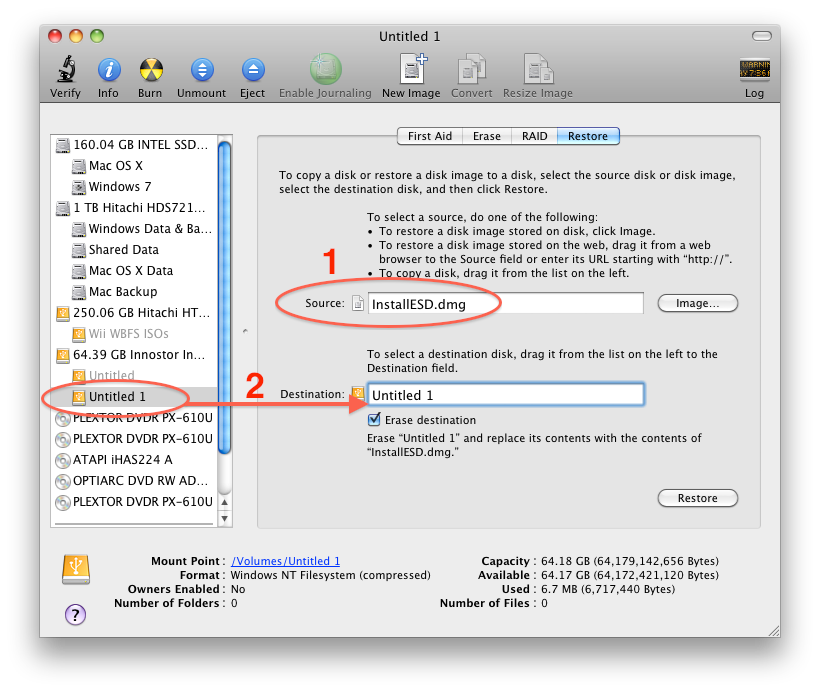Disk Utility Dmg To Usb
- With OS X El Capitan and later versions of the Mac OS, Apple changed the process for using Disk Utility to clone a Mac’s drive. While it's still possible to create an exact copy (a clone) of any drive connected directly to your Mac, the changes made to Disk Utility means there are extra steps involved if you wish to use Disk Utility’s Restore function to clone your startup drive.
- To create a bootable macOS installation disk, you have to burn the DMG file to a USB drive as CD/DVD is not available for Mac computers. Here's how to do it from text commands and using a purpose-built software called WizDMG.
- Make a bootable usb flash drive to install Panther OS X, Tiger OSX, Leopard OSX, Snow Leopard OSX, Lion OSX, Mountain Lion OSX, Mavericks OSX, Macbook pro, iMac, macbook air, macbook, macbook.
And backup the data in that USB drive as the installer erase all content from it. Open Disk Utility app and format the USB drive with APFS or Mac OS Extended. Open the Terminal app and copy-and-past the following commands to make a booatble USB installer from macOS image. But even novice users can learn to burn a DMG file to a disk. Disk Images, or DMGs, are a common way to compress large files on Mac computers, including apps. Because these files can often be a few gigabytes in size, a USB flash drive is usually the fastest way.
On every OS X Lion installation a hidden partition is created to enable a method for Lion to be reinstalled on the machine, it is known as the recovery partition or drive and is 650mb in size. How to remove advanced mac cleaner.
If you bought a new machine from Apple you have OS X 10.7 already installed – but no back up disk! and since you haven’t bought the OSX Lion 10.7 App from the App store you can’t re-download it – so thats why you have the recovery drive as a partition in your main hard drive and to boot from it you need to restart the machine holding down “command” + “r” keys.
From recovery mode you can run Disk Utility, get online help and do a restore from a Time Machine backup and re-install Lion leaving all your other files intact – it just replaces the core operating system.
You can make a bootable USB drive or disk of the recovery drive, but involves a small trip to the Terminal….
1) Launch Terminal from /Applications/Utilities and run:
The primary drive in this list is No.2 with the “Identifier” of disk0s2, the boot recovery drive is disk0s3
We can also identify the recovery drive by the name and the size – set at 650mb
2) Mount the drive:
Output should be:
Now the Recovery HD is mounted in the Finder and you can see it in the sidebar under Devices
Navigate to it from the sidebar – Recovery HD/com.apple.recovery.boot/BaseSystem.dmg. Peerblock download mac.
3) Doubleclick BaseSystem.dmg to mount it also in the sidebar. This will mount the volume ” Mac OSX Base System”
mac-osx-lion-base-system
4) Open Disk Utility in /Applications/Utilities
5) Put in a 2GB+ USB drive, let Disk Utility load it. The USB drive needs to be formatted as Mac OS Extended Journaled, if its not, its time to format it in Disk Utility…
6) Finally in still in Disk Utility, select the “Restore” tab – drag the mounted volume “Mac OSX Base System” into the Source field and drag the USB drive “Volume” (mine is called SuperBootUSBDrive) to the Destination.
restore-volume-osx-usb

7) Click Restore – 25 minutes later – One bootable USB drive
Your bootable USB drive will be called “Mac OS X Base System” after the restore is complete. Now to boot from it just select it as the Start Up disk in System Preferences or hold down option key on boot and select it from the choice of bootable devices.
Burn Dmg To Usb Mac Disk Utility
If you have downloaded the Lion App from the App Store then you can also make a boot disk/drive from this, guide is here, you need to make the boot drive/disk before you install the Lion App, as the installer is deleted after running it. Thats why the guide here can get you out of trouble.
Disk Utility Dmg To Usb Converter
Couple of footnotes on this – Apple has released a knowledgebase article about the recovery partition, also just released from Apple is an app that will do the same as above.
Update For Newer Models – hidden BaseSystem.dmg
If you have the latest models from Apple that came already shipped with OSX 10.7, then you may not have the “BaseSystem.dmg” but instead see a “BaseSystem.chunklist” , the “BaseSystem.dmg” is there it’s just hidden.
To show it so you can see it in the finder – go to Terminal – enter:
Now it will be visible in the Finder.